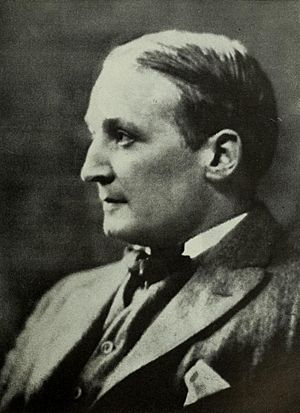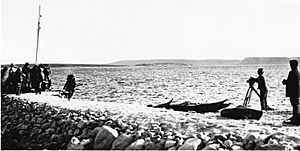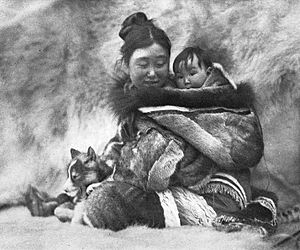Robert J. Flaherty facts for kids
Quick facts for kids
Robert J. Flaherty
|
|
|---|---|

Flaherty in 1922
|
|
| Born |
Robert Joseph Flaherty
February 16, 1884 Iron Mountain, Michigan, U.S.
|
| Died | July 23, 1951 (aged 67) Dummerston, Vermont, U.S.
|
| Occupation | Filmmaker |
| Spouse(s) | Frances Johnson Hubbard |
| Children | Monica Flaherty Frassetto, 3 others |
Robert Joseph Flaherty (February 16, 1884 – July 23, 1951) was an American filmmaker. He is famous for directing and producing Nanook of the North (1922). This was the first successful full-length documentary film.
Because of Nanook, Flaherty became very well known. He is often called the "father" of both the documentary and the ethnographic film. An ethnographic film shows the culture and way of life of a group of people. He also made other important films like Moana (1926) and Man of Aran (1934).
Flaherty was married to writer Frances H. Flaherty from 1914 until he passed away. Frances helped a lot with his films. She even received an Academy Award nomination for her work on Louisiana Story (1948).
Contents
Early Life and Interests
Robert Flaherty was one of seven children. His father explored for iron ore. Because of his father's work, Robert traveled a lot. This made him curious about people from different cultures.
Before making films, Flaherty was a skilled photographer in Toronto. He took many pictures of American Indians and wildlife. These photos helped inspire him to create Nanook of the North. He wanted to show the lives of these people through a new kind of film.
In 1914, he married Frances Hubbard. Frances came from a very educated family. She studied music and poetry in Paris. After they married, Frances became a key part of Robert's filmmaking success. She sometimes helped direct, edit, and even find film contracts.
In 1909, Flaherty shared stories he heard from an Inuk man named George Weetaltuk. Flaherty met Weetaltuk while looking for iron ore near Hudson Bay. He published a detailed map of the Inuit region based on Weetaltuk's information. These stories later appeared in his book, My Eskimo Friends: "Nanook of the North".
Making Nanook of the North
In 1913, Flaherty was exploring the Belcher Islands. His boss suggested he bring a movie camera. He took a Bell and Howell hand-cranked camera. He became fascinated by the Inuit people's lives. He spent so much time filming them that he almost forgot his main job.
When he returned to Toronto, he had 30,000 feet of film. Sadly, the film caught fire from his cigarette in his editing room. The film was destroyed, and his hands were burned. Even though he saved a copy, Flaherty wasn't happy with it. He felt it was just random scenes and boring.
Flaherty decided to make a new film. He wanted to show the daily life of a typical Inuk family. In 1920, he got money from Revillon Frères, a fur trade company. This allowed him to shoot what became Nanook of the North.
On August 15, 1920, Flaherty arrived in Port Harrison, Quebec. He brought two special movie cameras. He also brought equipment to develop, print, and show the film to the Inuit while he was still filming.
For Nanook, Flaherty asked local people to play roles, like actors in a play. To show traditional Inuit life, he also set up some scenes. For example, the ending where Nanook and his family are supposedly in danger was planned. A half-igloo was built with a side cut away for light, so Flaherty could film inside. Flaherty sometimes asked the Inuit not to use modern tools like rifles for hunting, even though they were common then. He wanted to show their traditional ways.
Nanook started a series of films by Flaherty about people struggling against nature. These included Moana: A Romance of the Golden Age, set in Samoa, and Man of Aran, filmed in Ireland. All these films showed the dangers of nature and how communities worked hard to survive.
Filming in Hollywood
Nanook of the North (1922) was a big success. After this, many film studios wanted to work with Flaherty. He signed a contract with Paramount Pictures to make another film like Nanook. He went to Samoa to film Moana (1926). He lived there with his family for over a year.
Flaherty had a unique way of working. He liked to live with the community first to understand their way of life. Only then would he write a story to film. This was different from how Hollywood studios usually worked. Moana was not as popular in the U.S. as Nanook, but it did very well in Europe. It even inspired John Grierson to create the word "documentary."
Before Moana was released, Flaherty made two short films in New York City. These were The Pottery Maker (1925) and The Twenty-Four Dollar Island (1927). He also tried working with other studios like Metro-Goldwyn-Mayer and Fox Film Corporation. However, his creative style often clashed with Hollywood's way of making movies. Some of his footage was even lost in a studio fire.
Working in Britain and Ireland
After his time in Hollywood, Flaherty went to London. He worked on a documentary called Industrial Britain (1931). However, Flaherty's filming methods were expensive. He shot a lot of film compared to the final movie's length. This caused cost problems, and others had to finish the project.
Flaherty also wrote a novel about the sea called The Captain's Chair. It was published in 1938. Later that year, it was made into a TV show by the BBC.
His career in Britain ended when a producer removed him from the film Elephant Boy (1937). The producer wanted to make it a more commercial movie.
Later, Flaherty directed Man of Aran (1934). This film showed the tough traditional life of people on the Aran Islands off Ireland. The film was very successful. Like Nanook, Man of Aran showed people trying to survive in very difficult conditions. The islanders even carried seaweed from the sea to create fields for farming.
Flaherty again used local people as actors. He also recreated some old traditions that the islanders no longer practiced. For example, he filmed a scene of men hunting sharks with harpoons from small boats. This was something they hadn't done for decades. He also staged a dramatic scene where three men in a small boat struggled to row through dangerous, rocky seas.
Later Years and Films
Back in the United States, Flaherty was hired to film a documentary about American agriculture. This project became The Land. Flaherty and his wife traveled a huge distance, filming many striking images of rural America. The film showed challenges like land erosion and the Dust Bowl. It also showed new farming methods and people moving from the Great Plains to California.
The Land faced many problems. The government agency that hired him was closed. Also, as World War II approached, officials worried the film might make the U.S. look bad internationally. So, even though it premiered at a museum, it was never widely released.
Louisiana Story (1948) was another documentary by Flaherty. It was about installing an oil rig in a Louisiana swamp. The film showed the oil rig peacefully existing with nature. This film was actually paid for by Standard Oil, an oil company. The main character was a Cajun boy. Some critics say the film used the beauty of childhood and nature to make oil exploration look good.
Flaherty also helped make The Titan: Story of Michelangelo (1950). This film won an Academy Award for Best Documentary Feature. It was a new version of an older German/Swiss film about Michelangelo.
Legacy and Impact
Robert Flaherty is seen as a pioneer in documentary film. He was one of the first to combine real-life subjects with a story-like approach, similar to fiction films.
Flaherty was also an explorer. He was honored by the Royal Geographical Society of England for rediscovering the main island of the Belcher group in Hudson Bay in 1914. Flaherty Island, one of the Belcher Islands, is named after him.
The Flaherty Seminar is an annual event for filmmakers and film lovers. It was started by his wife in 1955 to honor him.
A documentary called A Boatload of Wild Irishmen (2010) looks closely at Flaherty's work. It discusses how his films sometimes staged scenes. It also points out that his films became valuable records for future generations of indigenous people. They showed ways of life that no longer exist.
In 1994, Robert Flaherty was played by actor Charles Dance in the film Kabloonak. This movie showed the making of Nanook of the North from the perspective of the Inuit people.
Robert Joseph Flaherty's grandson's wife, Louise Flaherty, is important too. She co-founded Canada's first independent Inuk publishing house, Inhabit Media.
Awards
- BAFTA presents the Robert J. Flaherty Award for best one-off documentary.
- Academy Award Oscar - Best Documentary Feature 1950 - The Titan: Story of Michelangelo
- 1913, Fellow, Royal Geographical Society
Filmography
Films
- Nanook of the North (1922)
- "The Pottery Maker" (1925)
- Moana (1926)
- "Twenty-Four-Dollar Island" (1927)
- Man of Aran (1934)
- "Oidhche Sheanchais (A Night of Storytelling)" (1935)
- Elephant Boy (1937; with Zoltan Korda)
- The Land (1942; made for the U.S. Department of Agriculture)
- Louisiana Story (1948)
Other work
- White Shadows in the South Seas (1928; uncredited footage)
- Acoma the Sky City (1929; unfinished film)
- Tabu (1931; screenplay with F. W. Murnau)
- "Industrial Britain" (1933; co-producer with John Grierson)
- "The Glassmakers of England" (1935; co-producer with John Grierson)
- "The English Potter" (1935; co-producer with John Grierson)
- The Titan: Story of Michelangelo (1950; co-producer with Ralph Alswang and Robert Snyder)
See also
 In Spanish: Robert J. Flaherty para niños
In Spanish: Robert J. Flaherty para niños
- Docufiction
- Ethnofiction
- Ó Flaithbertaigh



